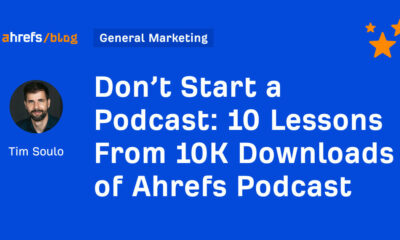SOCIAL
Twitter Will Soon Incorporate Podcast Access into its Audio Tab

While the audio social trend has died down, Twitter remains confident that there’s a future in its audio options, as it continues to develop Spaces and its dedicated audio tab, even if the listener numbers don’t seem to reflect any major user interest.
Twitter’s next big push on this front looks to be coming soon, with its new ‘Stations’ approach, incorporating popular podcasts alongside Spaces, both live and recorded, now close to a launch, according to the latest findings in the back-end code of the app.
As you can see in this screenshot, shared by app researcher Alessandro Paluzzi, there’s now an introductory screen for the option in the app, which notes that the audio tab will soon include both podcasts and Spaces, providing more options for listeners, either live or when they can tune in.
Which is important, because thus far, audio discovery hasn’t been entirely great on Twitter. Giving all users the capacity to stream in real-time can be a valuable addition, but as more people broadcast, that, inevitably, means that more junk will also clutter the feed, and algorithmic sorting in this respect can be difficult, because you’re trying to highlight the best discussions in real-time, and it’s virtually impossible to measure the quality of each broadcast as it’s happening.
Which is why it’s easier to showcase top shows and highlights from known creators, alongside a more curated collection of top Spaces, post-broadcast, which Twitter will be hoping will improve Spaces discovery, and provide another means for creators to showcase their work and build any audience in the app.

If creators, big and small, find more value airing their content on Twitter, alongside the added benefit of real-time tweet discussion, that could, theoretically, be a valuable tweet addition. But it is theoretical, and it may not play out that way in reality.
But the concept makes sense. For years, Twitter has been trying to figure out a way to merge real-time media discussion with its own, in-stream content – because Twitter, in its own words, is ‘the home of breaking news and updates.
“Fans love to see when their favorite podcasts are launching a new season, going on tour, or endorsing a fellow podcast for their next listen. Up-and-coming and established podcasters alike are using Twitter to help expand and inform their audience.”
Indeed, Twitter has established itself as the leader in real-time engagement around major media events – but capitalizing on such has proven challenging for the app.
For years, Twitter tried to merge TV broadcasts and tweet engagement into a single stream, in order to make its platform a more central medium for such discussion, with mixed results.

It’s now taking a similar approach with audio – but whether people actually want to tune in and engage with such within Twitter remains to be seen
In theory, though, it should work. Merging video and tweets never came together because Twitter’s seen as a secondary channel, and merging the two was too much, especially for not users. But audio is a background element – you can listen to audio and check out the related tweets in real-time, which should work to help prop up tweet engagement, creator options, podcast promotion, etc.
Though again, ‘should’ is the key term here.
The question is, are people really interested in tuning into audio on Twitter – and is social audio really a sustainable element, or was it actually just a short-term, pandemic-induced fad, that people have now lost interest in, for the most part.
Definitely, Clubhouse is struggling to maintain momentum, while Meta has all but abandoned its audio social initiatives. LinkedIn is still working on its variation on the same – but in general, the trendline is not great for social audio, which doesn’t paint the most optimistic picture for Spaces, even with this coming expansion.

Really, it’s increasingly looking like a niche interest area, which is of huge value for those that are into the option (yes, I realize you all also exist), but not a major point of note for the vast majority, which makes it seem like a bit of a dead-end, in terms of development.
But Twitter has the data, and again, there does seem to be potential in combining the actual media being discussed with tweet engagement.
Maybe, this will give Twitter another tool to add into its evolving creator options, providing more capacity for publishers to put more focus on the app.







![SEO Experts Gather for a Candid Chat About Search [Podcast] SEO Experts Gather for a Candid Chat About Search [Podcast]](https://articles.entireweb.com/wp-content/uploads/2024/09/SEO-Experts-Gather-for-a-Candid-Chat-About-Search-Podcast-400x240.png)
![SEO Experts Gather for a Candid Chat About Search [Podcast] SEO Experts Gather for a Candid Chat About Search [Podcast]](https://articles.entireweb.com/wp-content/uploads/2024/09/SEO-Experts-Gather-for-a-Candid-Chat-About-Search-Podcast-80x80.png)










You must be logged in to post a comment Login